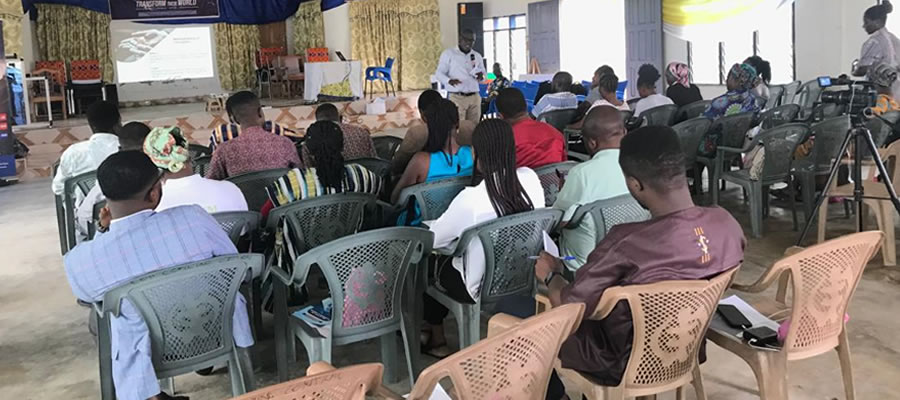

Water and Sanitation
Main source of drinking water and for other domestic purpose
Main source of drinking water
The main sources of drinking water by types of locality. In the District, the major sources of drinking water for households are river/stream and bore-hole/pump/tube well.
Approximately 44 percent of households in the District use river/stream while 37.9 percent use bore-hole/pump/tube well. Other sources of drinking water are public tap/stand pipe (0.9%), sachet water (4.3%), and protected well (4.3%).
Households in both urban (83.1%) and rural areas (40.8%) depend largely on river /stream. Much dependency on river/stream by both urban and rural households could be attributed to the inadequacy of borehole facilities in the District. The situation is not favourable in the urban areas as a result of few boreholes/pumps/tubes well (7.7%) compared to rural areas (40.2%) largely depend on rivers/streams.
The disparities among rural and urban areas in relation to the sources of drinking water. Urban areas have higher proportions for all the sources of drinking water (rivers/streams 83.1%, pipe- borne inside dwelling 0.2%, pipe- borne outside dwelling 2.7%, rain water 2.7% and other 0.1%) as compared to the rural areas except dugouts/ponds/lakes/dams/canals (1.7%), protected well (4.6%), unprotected wells (2%), 63 protected spring (0.4%) unprotected spring (0.2%), boreholes/pumps/tubes wells (40.2%) and public taps/standpipes (1%) which are highly patronised in the rural areas.
Main Source of Water for other Domestic Use
Table 8.11 indicates the main sources of water used by households for other domestic activities. Streams/rivers (49.1%) is the most common source of water used by households for other domestic activities such as washing of clothes, cooking utensils and vehicles. This is followed by boreholes/pumps/tube wells (35.8%), protected wells (6%), and unprotected wells (2.8%).
In urban areas, households depend more on three sources; rivers/streams (88.7%) ,pipe borne outside dwelling (1.9%), and boreholes/pumps/tubes (7.1%) whiles in rural areas, households use more of boreholes/ pumps/tubes (38%), rivers/streams (46%), and protected well (6.4%).
Bathing and toilet facilities
Toilet facilities
The types of toilet facilities used by households by type of locality. These facilities include; WC, pit latrine, KVIP, bucket/pan, public toilet and other. Out of the total households of 18,098 in the District, 2,294 (12.7%) do not have any form of toilet facility and 15,804 (87.3%) use one form or the other.
Households use pit latrine which is the most used toilet facility in the District and this is followed by public toilet-WC, KVIP, Pit, Pan etc (24.2%). Approximately 13 percent (12.7%) of households who do not have any form of toilet facility constitute the third highest households usage of the facility.
Comparing types of toilet facilities usage by type of locality (rural, urban), pit latrine which is the most used has 57 percent and 54.6 percent households using it in urban and rural areas respectively.
With Water Closet (WC) which is the most hygienic form of toilet facility has more rural households using it (152) than those in urban areas (11). But in terms of percentage, both localities recorded the same (0.9%).
The pictorial view of the types of toilet facilities used in the District by types of locality. It shows that pit latrine is mostly used by households in both localities (urban, rural).
Bathing Facilities
The type of bathing facilities used by households by type of locality in the district has been shown in Table 8.13. The main bathing facilities used in the district by households are shared open cubicle, own bathroom for exclusive use and shared separate bathroom in the same house. Accordingly, out of the total households of 18,098, 25.3 percent use shared open cubicle, own bathroom for exclusive use (25%) and shared separate bathrooms in the same house (24.4%).
Table 8.13 further indicates that in urban areas, most households (51.6%) use shared open cubicle whiles in rural areas, 26 percent used own bathrooms exclusively.
Methods of Waste Disposal
Methods of solid waste disposal
The methods of solid waste disposal in the district by type of locality. The main methods of disposing solid waste in the District are public dumps (open space), indiscriminate dumping and burning by household.
Household use of these main methods varies; approximately 52 percent (51.6%) use public dump (open space), 23.1 percent dump indiscriminately and 13 percent burn their refuse. In urban areas however, 74.8 percent of households dump in public dump (open space) whiles 49.8 percent use the same method in rural areas. However, 23.8 percent households in rural areas dump indiscriminately whiles 13.5 percent do same in urban areas. Moreover, the burning method by households is used mostly in rural areas (14.1%) than in urban areas (3.5%).
Methods of liquid waste disposal
The method of liquid waste disposal in the district by type of locality. Households mostly dispose their liquid waste either by throwing onto compound, streets/outside or into gutters. It could be realised that approximately 66 percent (65.5%) of households dispose onto compound, 24.7 percent use the streets/outside and 6.5 percent use gutter.
In both urban and rural areas, liquid waste is mostly thrown onto compounds and this constitutes 68.4 percent for urban households and 65.3 percent for rural households. The least method of disposing liquid waste by urban households is drainage system into gutters (0.4%) whiles in rural households it is through the sewage system (0.4%).
Date Created : 11/23/2017 7:42:00 AM











 facebook
facebook
 twitter
twitter
 Youtube
Youtube
 +233 593 831 280
+233 593 831 280 0800 430 430
0800 430 430 GPS: GE-231-4383
GPS: GE-231-4383 info@ghanadistricts.com
info@ghanadistricts.com Box GP1044, Accra, Ghana
Box GP1044, Accra, Ghana